The implications of the EMIR Refit

Due to the changing landscape since the initial inception in 2012, the original EMIR (European Market Infrastructure Regulation) legislation has become outdated.
The EMIR Refit was originally introduced with the goal of simplifying regulations, and these new requirements took effect in 2019. Following the EMIR Refit, there has been a subsequent round of amendments and updated technical guidelines. In this article, we highlight the key changes.
ESMA has published the final reporting guidelines for the updated EMIR refit to take effect on 29 April 2024 (Europe) and 30 September 2024 (UK). These changes, while strivinging to streamline and standardise the reporting across Trade repositories, will add some initial challenges in setting up the new report and reporting format.
Although a significant number of corporates rely on the financial counterparty to report on their behalf, these changes can still cause a major headache for corporates that continue reporting by themselves or need to report internal trades.
Key changes
The first major change concerns the number of fields that can be reported on. Currently there are 129 reportable fields, under the updated legislation there is a withdrawal of 15 and 89 new fields. This brings the new report to a hefty 203 reportable fields.
There will be an introduction of more counterparty-specific fields. These fields will require a deeper understanding of and communication with all counterparties. New counterparty data that will be required includes a Clearing Threshold and Corporate Sector.
The way that these fields will be reported is under huge review. The updated legislation will remove the CSV file, a business staple due to its ease of creation and flexibility, and replace the file with an XML submission using ISO 20022 standards. This move to XML will give corporates the headache of building the necessary XML file. One benefit of the XML format is that it will make moving between Trade Repositories easier as there will be a uniform file specification.
Introducing UPI
Another major change concerns the introduction of a Unique Product Identifier (UPI). The UPI is aimed at reducing the misreporting of products, ISINs, CFI codes, and other classifications. The UPI will be controlled and issued by the Derivatives Service Bureau (DSB). With a central database of identifiers, this should reduce misreporting. It is also hoped that the use of a centrally managed UPI will lead to a reduction in the number of reportable fields in the future . A downside to this change is that companies will need to sign up with the DSB and a fee will be charged for each UPI. There is a general consensus that with the introduction of the UPI, the UTI is likely to be phased out and removed in the future.
One easily missed detail on the new requirements is the necessity to update all outstanding trades to the new reporting format and level of detail, within 6 months of the go-live. This can be problematic for firms that don’t have the necessary data points for the historic trades and will require a review to bring these trades up to the required reporting standard.
In summary, there are large changes in the number of fields needing to be reported, much more granularity required from dealing counterparties, and a change of file type to XML.
Reporting validations and final report can be found on the ESMA website.
With our experience in EMIR and EMIR Refit legislation we can help with the transition to the new reporting requirements.
Please contact Keith Tolfrey or Wilco Noteboom for further insights.
Why developing a non-maturing deposit model should be the top priority for banks in the Nordics

Due to the changing landscape since the initial inception in 2012, the original EMIR (European Market Infrastructure Regulation) legislation has become outdated.
First and foremost, the long period of low and even negative swap rates was followed by strongly rising rates and a volatile market, which impacted the behavior of both customers and banks themselves. At the same time, regulatory developments, initiated by EBA’s new IRRBB guidelines, have shifted the banks’ focus to managing their earnings and earnings risk, rather than economic value risks.
Non-maturing deposits (NMDs) are of particular interest in this respect, given the uncertainty regarding the future pricing strategy and volume developments involved in these products. Moreover, as NMDs are generally modeled with a rather short maturity, the portfolio plays a significant role in the stability of the NII, making this portfolio even more relevant to evaluate in light of the newly introduced Supervisory Outlier Test (SOT) limits on earnings risk (more specific NII), or the local equivalent.
How does this affect IRRBB management at banks?
The exact impact of these developments is also heavily dependent on the bank’s local market, and corresponding laws and regulation, as well as the balance sheet composition of the bank. In Nordics countries, banks are affected more heavily, given that loans and mortgages generally have shorter maturities, as compared to other Western European countries like Germany and the Netherlands. This yields a smaller maturity mismatch with on-demand deposits at the liability side, such that a natural hedge exists to some extent within the balance sheet. Earlier on, this effect, combined with the rather stable markets, made active ALM, including IRRBB management, less urgent. The incentive to accurately model NMDs was therefore limited, so most banks simply replicate this funding overnight, while banks in other European countries tend to use a longer maturity, as illustrated by figure 1.

{Figure 1: Difference in average repricing maturity of NMDs between Nordic banks and other European banks, based on Pillar 3 IRRBBA and IRRBB1 disclosures from 2022 annual reports}
While the natural hedge already (partially) mitigates the risks from a value perspective to a large extent, investing the full NMDs portfolio overnight leads to relatively high NII volatility, thereby potentially violating regulatory limitations. The return on overnight investments will directly reflect any changes in the market rates, while deposit rates in reality are usually somewhat slower to include such developments. Although the resulting asymmetry between the investment return and deposit rate to be paid to customers yields a positive result under rising interest rates, it can reduce profits when interest rates start to fall.
Historically, banks in the Nordics experienced less flexibility in the modeling of NMDs, due to regulatory guidelines being somewhat stricter than EBA guidelines. For instance, Sweden’s Finansinspektionen (FI) required banks to replicate these positions overnight. However, relatively recently, the FI updated its regulations (FI dnr 19-4434), allowing banks to somewhat extend the duration of the investment profile, for a limited portion of the portfolio, and up to a maturity of one year. This results in flexibility to update the investment profile to better reflect the expected repricing speed of deposit rates, which could lead to improved NII stability. Additionally, besides applying these revised NMD models for managing banking book risks, they can, when approved, also be used for effective and consistent capital charge calculations under Pillar 2.
How can these developments be properly managed?
Even though the recent market developments create additional challenges in IRRBB management for banks, they also provide opportunities. The margin on deposit products for banks is currently improving, since only part of the interest rate rises is passed through to customers. The increased interest rates also mean that more advanced NMD models, with longer maturity profiles, can have a positive impact on the P&L, while simultaneously improving the interest rate risk management.
In such a rare win-win situation, it is more advantageous than ever to prioritize NMD modeling. In reassessing the interest rate risk management approach towards NMDs, banks should explicitly balance the tradeoff between value and earnings stability when making conceptual choices. These conceptual choices should align with the overall IRBBB strategy, as well as the intended use of the model, to ensure the risk in the portfolio is properly managed.
In weighing these conceptual alternatives, it is essential to take portfolio-specific characteristics into account. This requires an analysis of historical behavior, and an interpretation of how representative this information is. If behavior is expected to change, a common approach is to supplement historical data with expert expectations of forward-looking scenarios to develop a model that reflects both. Periodically reassessing the conceptual choices ensures a proper model lifecycle of NMD portfolios. This is crucial for accurate measurement of interest rate risk as well as for staying competitive in the current market environment.
Would you like to hear more? Contact Bas van Oers for questions on developing a non-maturing deposit model.
Roundtable ‘Climate Scenario Design & Stress Testing’ recap

On Thursday 15 June 2023, Zanders hosted a roundtable on ‘Climate Scenario Design & Stress Testing’. This article discusses our view on the topic and highlights key insights from the roundtable.
On Thursday 15 June 2023, Zanders hosted a roundtable on ‘Climate Scenario Design & Stress Testing’. In our head office in Utrecht, we welcomed risk managers from several Dutch banks. This article discusses our view on the topic and highlights key insights from the roundtable.
In recent years, many banks took their first steps in the integration of climate and environmental (C&E) risks into their risk management frameworks. The initial work on climate-related risk modeling often took the form of scenario analysis and stress testing. For example, as part of the Internal Capital Adequacy Assessment Process (ICAAP) or by participating in the 2022 Climate Stress Test by the European Central Bank (ECB). To comply with the ECB’s expectations on C&E risks, banks are actively exploring methodologies and data sources for adequate climate scenario design and stress testing. The ECB requires that banks will meet their expectations on this topic by 31 December 2024.
Our view
We believe that banks should start early with climate stress testing, but in a manageable and pragmatic way. Banks can then improve their methodologies and extend their scope over time. This allows for a gradual development of knowledge, data and methodologies within all relevant Risk teams. Zanders has identified the following steps in the process of climate scenario design and stress testing:
- Step 1: Scenario selection
A bank has to select appropriate (climate) scenarios based on the bank’s climate risk materiality assessment. Important to consider in this phase is the purpose for which the scenarios will be used, whether the scenarios are in line with scientific pathways, and whether they account for different policy outcomes (like an early or late transition to a sustainable economy).
- Step 2: Scope and variable definition
An appropriate scope must then be selected and appropriate variables defined. For example, banks need to determine which portfolios to take in scope, which time horizons to include, select the granularity of the output, the right level of stress, and which climate- and macro-economic variables to consider.
- Step 3: Methodology
Then, the bank needs to develop methodologies to calculate the impact of the scenarios. There are no one-size-fits-all approaches and often a combination of different qualitative and quantitative methodologies is needed. We recommend that the climate stress test approach be initially simple and to focus on material exposures.
- Step 4: Results
It is important to use the results of the scenario analysis in the relevant risk and business processes. The results can be used for the bank’s risk appetite and strategy. The results can also help to create awareness and understanding among internal stakeholders, and support external disclosures and compliance.
- Step 5: Stress testing framework
Finally, banks should establish minimum standards for climate scenario design and stress testing. This framework should include, amongst others, policies and processes for data collection from different sources, how adequate knowledge and resources are ensured, and how the scenarios are kept up-to-date with the latest market developments.
Key insights
Prior to the roundtable, participants filled in a survey related to the progress, scope and challenges on climate risk stress testing. The key insights presented below are based on the results of this survey, together with the outcomes of the discussion thereafter.
The financial sector has advanced with several aspects around integrating climate risks in risk management over the past year. This was recognized by all participants, as they had all performed some form of climate risk stress testing. The scope of the stress testing, however, was relatively limited in some cases. For example, all participants considered credit risk in their climate risk scenario with many also including market risk. Only a limited number of participants took other risk types into account.
Furthermore, all participants assessed the short-term impact (up to 3 years) of the climate scenarios, whereas only around 40% and 10% assessed the impact on the medium term (3 to 10 years) and long term (>10 years), respectively. This is probably related to the fact that all participants used climate scenarios in their ICAAP, which typically covers a three-year horizon. The second most mentioned use for the climate scenarios, after the ICAAP, was the risk identification & materiality analysis. A smaller percentage of participants also used the climate scenarios for business strategy setting, ILAAP and portfolio management.
The two topics that were unanimously mentioned as the main challenges in climate risk stress testing are data selection and gathering, and the quantification of climate risks into financial impacts, as shown in the graph below:
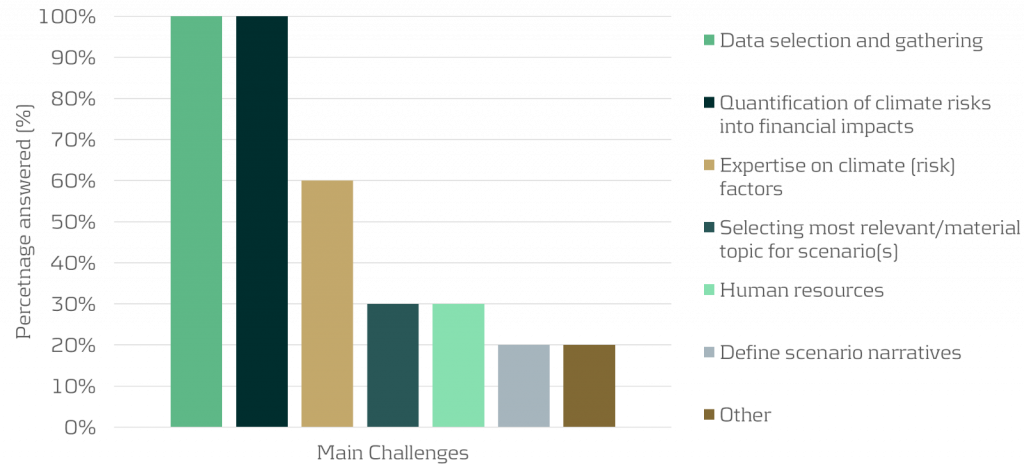
- Insight 1: Assessing impact of climate risk beyond the short-term very much increases the complexity and uncertainty of the exercise
The participants indicated that climate stress testing beyond the short-term horizon (beyond 3 to 5 years) is very difficult. Beyond that horizon, the complexity of the (climate) scenarios increases materially due to uncertainties of clients’ transition plans, the bank’s own transition plan and climate strategy (e.g., related to pricing and client acceptance policies), and climate policies and actions from governments and regulators. Taking the transition plans of clients into account on a granular level is especially difficult when there is a large number of counterparties. There are no clear solutions to this. Some ideas that take longer-term effects into account were floated, such as adjusting the current valuation of various assets by translating future climate impact on assets into a net present value of impact or by taking climate impacts into account in the long-term macro-economic scenarios of IFRS9 models.
- Insight 2: Whether to use a top-down or bottom-up approach depends on the circumstances
It was discussed whether a bottom-up stress test for climate scenarios is preferable to a top-down stress test. The consensus was that this depends on the circumstances, for example:- Physical risks are asset- and location-specific; one street may flood but not the next. So, in that case a bottom-up assessment may be necessary for a more granular approach. On the other hand, for transition risks, less granularity might be sufficient as transition policies are defined on national or even supranational level, and trends and developments often materialize on sector-level. In those cases, a top-down type of analysis could be sufficient.
- If the climate stress test is used to get a general overview of where risks are concentrated, a top-down analysis may be appropriate. However, if it is used to steer clients, a more granular, bottom-up approach may be needed.
- A bottom-up approach could also be more suitable for longer-term scenarios as it allows to include counterparty-specific transition plans. For more short-term scenarios, a sector average may be sufficient, considering that there will be less transition during this period.
- Insight 3: Translating the results of climate risk stress testing into concrete actions is challenging
The results of the stress test can be used to further integrate climate risk into risk management processes such as materiality assessment, risk appetite, pricing, and client acceptance. Most participants, however, were still hesitant to link any binding actions to the results, such as setting risk limits (e.g., limiting exposures to a certain sector), adjusting client acceptance, or amending pricing policies. However, the ECB does require banks to consider climate impacts in these processes. The most mentioned uses of the climate risk stress testing results were risk identification & materiality assessments and risk monitoring.
Conclusion
Most banks have taken first steps in relation to climate scenario design and stress testing. However, many challenges still remain, for example around data selection and quantification methodologies. Efforts by banks, regulators and the market in general are required to overcome these challenges.
Zanders has already supported several banks with climate scenario design and stress testing. This includes the creation of a climate scenario design framework, the definition of climate scenarios, and by quantifying climate risk impacts for the ICAAP. Next to that, we have performed research on modeling approaches that can be used to quantify the impact of transition and physical risks. If you are interested to know how we can help your organization with this, please reach out to Marije Wiersma.
Performance of Dutch banks in the 2023 EBA stress test

Due to the changing landscape since the initial inception in 2012, the original EMIR (European Market Infrastructure Regulation) legislation has become outdated.
Seventy banks have been considered, which is an increase of twenty banks compared to the previous exercise. The portfolios of the participating banks contain around three quarters of all EU banking assets (Euro and non-Euro).
Interested in how the four Dutch banks participating in this EBA stress test exercise performed? In this short note we compare them with the EU average as represented in the results published [1].
General comments
The general conclusion from the EU wide stress test results is that EU banks seem sufficiently capitalized. We quote the main 5 points as highlighted in the EBA press release [1]:
- The results of the 2023 EU-wide stress test show that European banks remain resilient under an adverse scenario which combines a severe EU and global recession, increasing interest rates and higher credit spreads.
- This resilience of EU banks partly reflects a solid capital position at the start of the exercise, with an average fully-loaded CET1 ratio of 15% which allows banks to withstand the capital depletion under the adverse scenario.
- The capital depletion under the adverse stress test scenario is 459 bps, resulting in a fully loaded CET1 ratio at the end of the scenario of 10.4%. Higher earnings and better asset quality at the beginning of the 2023 both help moderate capital depletion under the adverse scenario.
- Despite combined losses of EUR 496bn, EU banks remain sufficiently apitalized to continue to support the economy also in times of severe stress.
- The high current level of macroeconomic uncertainty shows however the importance of remaining vigilant and that both supervisors and banks should be prepared for a possible worsening of economic conditions.
For further details we refer to the full EBA report [1].
Dutch banks
Making the case for transparency across the banking sector, the EBA has released a detailed breakdown of relevant figures for each individual bank. We use some of this data to gain further insight into the performance of the main Dutch banks versus the EU average.
CET1 ratios
Using the data presented by EBA [2], we display the evolution of the fully loaded CET1 ratio for the four banks versus the average over all EU banks in the figure below. The four Dutch banks are: ING, Rabobank, ABN AMRO and de Volksbank, ordered by size.
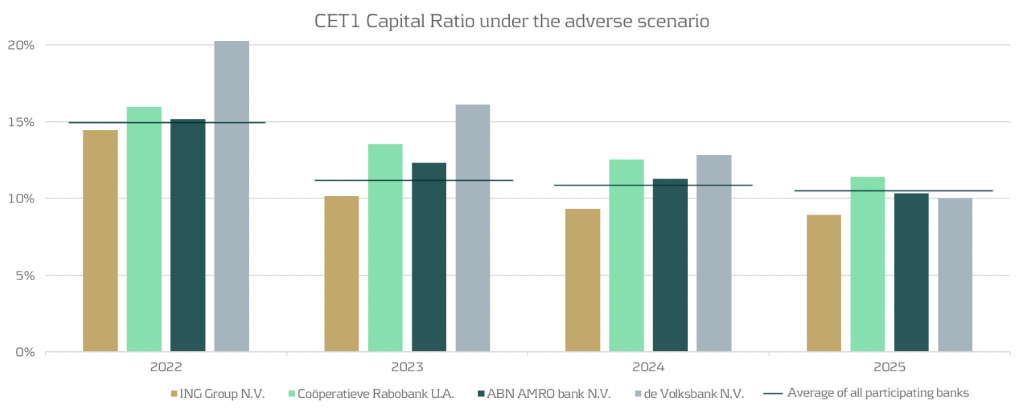
From the figure, we observe the following:
- Compared to the average EU-wide CET1 ratio (indicated by the horizontal lines in the graph above), it can be observed that three out of four of the banks are very close to the EU average.
- For the average EU wide CET1 ratio we observe a significant drop from year 1 to year 2, while for the Dutch banks the impact of the stress is more spread out over the full scenario horizon.
- The impact after year 4 of the stress horizon is more severe than the EU average for three out of four of the Dutch banks.
Evolution of retail mortgages during adverse scenario
The most important product the four Dutch banks have in common are the retail mortgages. We look at the evolution of the retail mortgage portfolios of the Dutch banks compared to the EU average. Using EBA data provided [2], we summarize this in the following chart:
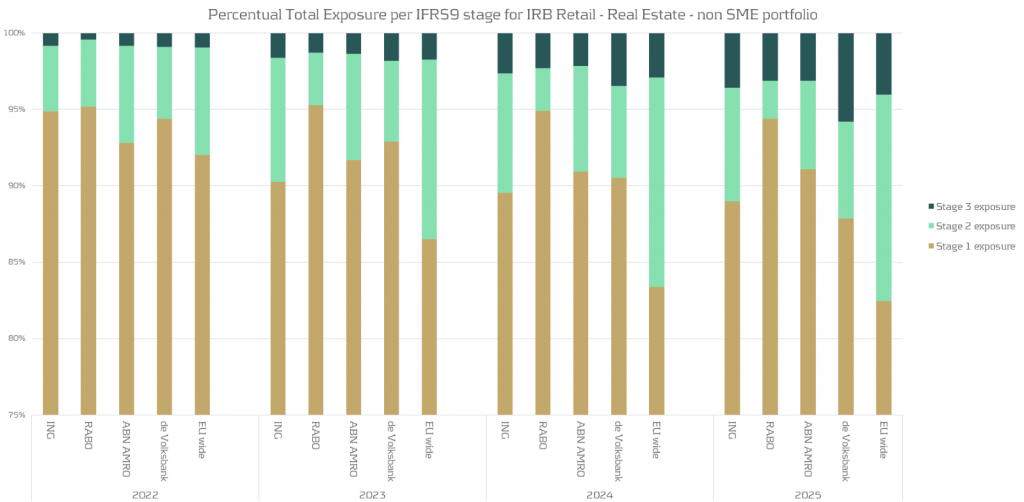
Based on the analysis above , we observe:
- There is a noticeable variation between the banks regarding the migrations between the IFRS stages.
- Compared to the EU average there are much less mortgages with a significant increase in credit risk (migrations to IFRS stage 2) for the Dutch banks. For some banks the percentage of loans in stage 2 is stable or even decreases.
Conclusion
This short note gives some indication of specifics of the 2023 EBA stress applied to the four main Dutch banks.
Should you wish to go deeper into this subject, Zanders has both the expertise and track record to assist financial organisations with all aspects of stress testing. Please get in touch.
References
Zanders listed on Swift Customer Security Programme (CSP) Assessment Providers directory

We are excited to announce that Zanders has been listed on the Swift Customer Security Programme (CSP) Assessment Providers directory*.
The CSP helps reinforce the controls protecting participants from cyberattack and ensures their effectivity and that they adhere to the current Swift security requirements.
*Swift does not certify, warrant, endorse or recommend any service provider listed in its directory and Swift customers are not required to use providers listed in the directory.
Swift Customer Security Programme
A new attestation must be submitted at least once a year between July and December, and also any time a change in architecture or compliance status occurs. Customer attestation and independent assessment of the CSCF v2023 version is now open and valid until 31 December 2023. July 2023 also marks the release of Swifts CSCF v2024 for early consultation, which is valid until 31 December 2024.
Swift introduced the Customer Security Programme to promote cybersecurity amongst its customers with the core component of the CSP being the Customer Security Controls Framework (CSCF). Independent assessment has been introduced as a prerequisite for attestation to enhance the integrity, consistency, and accuracy of attestations. Each year, Swift releases an updated version of the CSCF that needs to be attested to with support of an independent assessment.
The Attestation is a declaration of compliance with the Swift Customer Security Controls Policy and is submitted via the Swift KYC-SA tool. Dependent on the Swift Architecture used, the number of controls to be implemented vary; of which certain are mandatory, and others advisory.
Further details on the Swift CSCF can be found on their website:
- https://www.swift.com/myswift/customer-security-programme-csp
- https://www.swift.com/myswift/customer-security-programme-csp/find-external-support/directory-csp-assessment-providers
Our services
Do you have arrangements in place to complete the independent assessment required to support the attestation?
Zanders has experience with and can support the completion of an independent external assessment of your compliance to the Swift Customer Security Control Framework that can then be used to fully complete and sign-off the Swift attestation for this year.
With an extensive track record of designing and deploying bank integrations, our intricate knowledge of treasury systems across both IT architecture as well as business processes positions us well to be a trusted independent assessor. We draw on past projects and assessments to ask the right questions during the assessment phase, aligning our customers with the framework provided by Swift.
The Swift attestation can also form part of a wider initiative to further optimise your banking landscape, whether that be increasing the use of Swift within your organisation, bank rationalization or improving your existing processes. The availability of your published attestation and its possible consultation with counterparties (upon request) helps equally in performing day-to-day risk management.
Approach
Planning
We start with rigorous planning of the assessment project, developing a scope of work and planning resources accordingly. Our team of experts will work with clients to formulate an Impact Assessment based on the most recent version of the Swift Customer Security Controls Framework.
Architecture Classification
A key part of our support will be working with the client to formulate a comprehensive overview of the system architecture and identify the applicable controls dictated by the CSCF.
Perform Assessment
Using our wide-ranging experience, we will test the individual controls against specific scenarios designed to root out any weaknesses and document evidence of their compliance or where they can be improved.
Independent Assessment Report
Based on the evidence collected, we will prepare an Independent Assessment report which includes status of the compliance against individual controls, baselining them against the CSCF and recommendations for improvement areas within the system architecture.
Post Assessment Activities
Once completed, the Independent Assessment report will support you with the submission of the Attestation in line with the requirements of the CSCF version in force, which is required annually by Swift. In tandem, Zanders can deliver a plan for implementation of the recommendations within the report to ensure compliance with current and future years’ attestations. Swift expects controls compliance annually, together with the submission of the attestation by 31 December at the latest, in order to avoid being reported to your supervisor. Non-compliant status is visible to your counterparties.
Do you need support with your Swift CSP Independent Assessment?
We are thrilled to offer a Swift CSP Independent Assessment service and look forward to supporting our clients with their attestations, continuing their commitment to protecting the integrity of the Swift network, and in doing so supporting their businesses too. If you are interested in learning more about our services, please contact us directly below.
Get performance now
- Contact me
You are currently viewing a placeholder content from HubSpot. To access the actual content, click the button below. Please note that doing so will share data with third-party providers.
More Information
Machine learning in CRR-compliant IRB models

Due to the changing landscape since the initial inception in 2012, the original EMIR (European Market Infrastructure Regulation) legislation has become outdated.
Machine learning (ML) models have proven to be highly effective in the field of credit risk,
outperforming traditional regression models in their predictive power. Thanks to the exponential growth in the data availability, storage capacity and computational power, these models can be effectively trained on vast amounts of complex, unstructured data.
Despite these advantages, however, ML models have yet to be integrated into internal rating-based (IRB) modeling methodologies used by banks. This is mainly due to the fact that existing methods for calculating regulatory capital have remained largely unchanged for over 15 years, and the complexity of ML models can make it difficult to comply with the Capital Requirements Regulation (CRR). Nonetheless, the European Banking Authority (EBA) recognizes the potential of ML in the future of IRB modeling and is considering providing a set of principle-based recommendations to ensure its appropriate use.
In sight of these recommendations, the EBA published a discussion paper (EBA/DP/2021/04) to seek stakeholders’ feedback on the practical use of ML in the context of IRB modeling, aiming to provide clarity on supervisory expectations. This paper outlines the challenges and opportunities in using ML to develop CRR-compliant IRB models, and presents the point of view for various banking stakeholders on the topic.
Current use and potential benefits of ML in IRB models
According to research conducted by the Institute of International Finance (IIF) in 2019, the most
common uses of ML within credit risk are credit approval, credit monitoring and collections, and
restructuring and recovery. However, the use of ML within other regulatory areas, such as capital
requirements, stress testing and provisioning is highly limited. For IRB models, ML is used to
complement standard models used for capital requirement calculation. Examples of current uses of ML to complement standard models include (i) model validation, where the ML model serves as a challenger model, (ii) data improvements, where ML is used for more efficient data preparation and exploration, and (iii) variable selection, where ML is used to detect explanatory variables.
ML has the potential to provide a range of benefits for risk differentiation, including improvements in the model discriminatory power 1 , identification of relevant risk drivers 2 , and optimization of the portfolio segmentation. Based on their superior predictive ability and capacity to detect bias , ML models can also help to improve risk quantification 3 . Furthermore, ML can be used to enhance the data collection and preparation process, leading to improved data quality. Finally, ML models can enable the use of unstructured data, expanding the possible data sets allowing for the use of new parameters and estimation of these parameters.
Challenges to CRR compliance
The following table summarizes the challenges involved in using ML to develop IRB models that are compliant to prudential requirements.
| Area | Topic | Article ref. | Challenge |
| Risk differentiation | The definition and assignment criteria to grades or pools | CRR 171(1)(a) and (b) RTS on AM for IRB 24(1) | Use of ML is constrained when no clear economic relation between the input and the output variables. Institutions should explore suitable tools to interpret complex ML models. |
| Risk differentiation | Complementing human judgement | CRR 172(3) and 174(e) GL on PD and LGD 58 | Complexity in ML models may make it more difficult to take into account expert involvement and analyze the impact of human judgement on the performance of the model. |
| Risk differentiation | Documentation of modeling assumptions and theory behind the model | CRR 175(1) and (2), 175(4)(a) RTS on AM for IRB 41(d) | To document a clear outline of the theory, assumptions and mathematical basis of the final assignment of estimates to grades, exposures or pools may be difficult in complex ML models. Also, the institution’s relevant staff should fully understand the model’s capabilities and limitations. |
| Risk quantification | Plausibility and intuitiveness of the estimates | CRR 179(1)(a) | ML models can result in non-intuitive estimates, particularly when the structure of the model is not easily interpretable. |
| Risk quantification | Underlying historical observation period | CRR 180(1)(a) and (h), 180(2)(a) and (e), and 181(1)(j) and 181(2). | For PD and LGD estimation, the minimum length of the historical observation period is five years. This can be a challenge for the use of big data, which might not be available for a sufficient time horizon. |
| Validation | Interpreting and resolving validation findings | CRR 185(b) | Difficulties may arise in ML models in explaining material differences between the realized default rates and the expected range of variability of the PD estimates per grade. This also holds for assessing the effect of the economic cycle on the logic of the model. |
| Validation | Validation tasks | CRR 185 | It may be more difficult to assess the representativeness and to fulfill operational data requirements (e.g. data quality and maintenance). Furthermore, the validation function is expected to challenge the model design, assumptions and methodology, whereas a more complex model will be harder to challenge efficiently. |
| Governance | Corporate governance | CRR 189 | The institution’s management body is required to possess a general understanding of the rating systems of the institution and detailed comprehension of the associated management reports. |
| Operational | Implementation process | CRR 144, 171 RTS on AM for IRB 11(2)(b) | The complexity of ML models may make it more difficult to verify the correct implementation of internal ratings and risk parameters in IT systems. In particular, the heavy utilization of different packages will become challenging. |
| Operational | Categorization of model changes | CRR 143(3) | If models are updated at a high frequency with time-varying weights associated to variables, it may be difficult to categorize the model changes. For the validation function it is unfeasible to validate each model iteration. |
Expectations for a possible and prudent use of ML in IRB modeling
In January 2020, the EBA published a report on the recent trends of big data and advanced analytics (BD&AA) in the banking sector. In order to support ongoing technological neutrality – the freedom to choose the most appropriate technology adequate to their needs and requirements - the BD&AA report recommends the use of ML and suggests safeguards to ensure compliance. Meanwhile, the EBA has provided the following principles to clarify how to adhere to the regulatory requirements set out in the CRR for IRB models.
- All relevant stakeholders should have an appropriate level of knowledge of the model’s functioning. This includes the model development unit, credit risk control unit and validation unit, but also the management body and senior management, to a lesser extent.
- Zanders believes that appropriate trainings on the use of ML to the relevant stakeholders ensures the appropriate level of knowledge.
- Institutions should avoid unnecessary complexity in the modeling approach if it is not justified by a significant improvement in the predictive capabilities.
- Zanders advocates to focus on the use of explanatory drivers with significant predictive information to avoid including an excessive number of drivers. In addition, Zanders advises on which data type (unstructured or more conventional) and what modeling choice (simplistic or sophisticated) is appropriate for the institution to avoid unnecessary complexity.
- Institutions should ensure that the model is correctly interpreted and understood by relevant stakeholders.
- Zanders assesses the relationship of each single risk driver with the output variable, ceteris paribus, the weight of each risk driver to detect the level of influence on the model prediction, the economic relationship to ensure plausible and intuitive estimates, and the potential biases in the model, such that the model is correctly interpreted and understood.
- The application of human judgement in the development of the model and in performing overrides should be understood in terms of economic meaning, model logic, and model behavior.
- Zanders provides best market practice expertise in applying human judgement in the development and application of the model.
- The parameters of the model should generally be stable. Therefore, institutions should perform sensitivity analysis and identify/monitor reasons for regular updates.
- Zanders analyses whether a break in the economic conditions or in the institution’s processes or in the underlying data might justify a model update. Furthermore, Zanders evaluates the changes required to obtain stable parameters over a longer time horizon.
- Institutions should have a reliable validation, which covers overfitting issues, challenging the model design, reviewing representativeness and data quality issues, and analyzing the stability of estimates.
- Zanders provides validation activities following regulatory compliance.
Survey responses
The following stakeholders provided responses to the questions posed in the EBA paper (EBA/DP/2021/04):
- Asociación Española de Banca (AEB) – Spanish Banking Association
- Assilea – Italian Leasing Association
- Association for Financial Markets in Europe (AFME)
- European Association of Co-operative Banks (EACB)
- European Savings and Retail Banking Group (ESBG)
- Fédération Bancaire Française - French Banking Federation (FBF)
- Die deutsche Kreditwirtschaft – The German Banking Industry Committee (GBIC)
- Institute of International Finance (IIF)
- Mazars – audit, tax and advisory firm
- Prometeia SpA – advisory and tech solutions firm (SpA)
- Banca Intesa Sanpaolo – Italian international banking group (IIBG)
A summary of the responses to key questions is provided below.
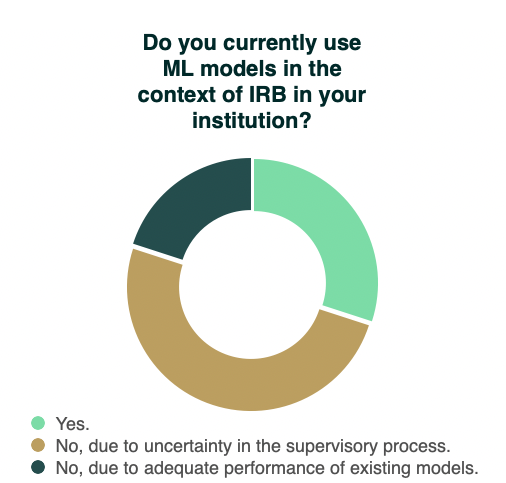
The vast majority of respondents does not currently apply ML for IRB purposes. The respondents argue that they would like to use ML for regulatory capital modeling, but that this is not deemed feasible without explicit regulatory guidelines and certainty in the supervisory process. AEB refers to the report published by the Bank of Spain in February 2021, where it was concluded that ML models perform better than traditional models in estimating the default rate, and that the potential economic benefits would be significant for financial institutions. AECB and GBIC indicate that the need for ML in regulatory capital modeling is currently not necessary as the predictive power of traditional models prove to be satisfactory. Three respondents presently use ML to some extent within IRB, such as for risk driver selection and risk differentiation. Only IIBG has actually developed a complete ML model for the estimation of PD of an SME retail portfolio, which has been validated by the supervisor in 2021.
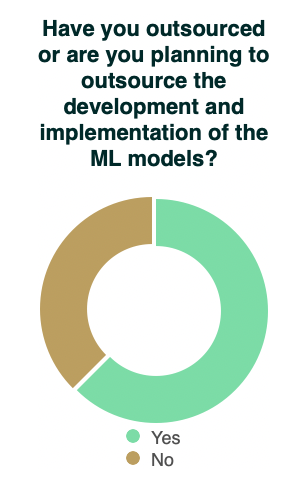
Five respondents answer that they would outsource the ML modeling for IRB to different degrees. AEB states that most of the work will be done internally and consulting services will be required at peak planning times. According to Mazars, the outsourcing is mainly performed on the development phase as banks would take over the ownership of the model and implement it in its IT infrastructure internally. The other respondents that plan to outsource foresee that external support is required for all phases. The remaining respondents state that they have not noticed any intention to outsource any of the parts or phases of the process on the development and implementation of the ML models.
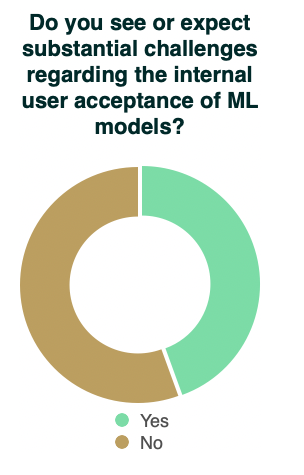
The respondents are split almost evenly on the topic of challenges regarding internal user acceptance of ML models. The respondents that see substantial challenges attribute this to the low explanatory power of ML-driven models and concerns on business representatives and credit officers being comfortable with the understanding and interactions of the standard approaches. However, for the latter it is recognized that specific trainings on ML methods are beneficial in this respect. The respondents that do not expect considerable challenges argue that ML models should be treated in the same manner as traditional methods as the same fundamental principles apply, where it is key to ensure that all Lines of Defense have the appropriate skills and responsibilities. Furthermore, the respondents state that existing ML applications, such as in AML, can be leveraged. The AFM explains that the techniques used to explain the results that are already available in those contexts are proving to be effective to understand the outcomes. SpA shares this sentiment and refers to Shapley values and the Lime test as techniques for model interpretability.
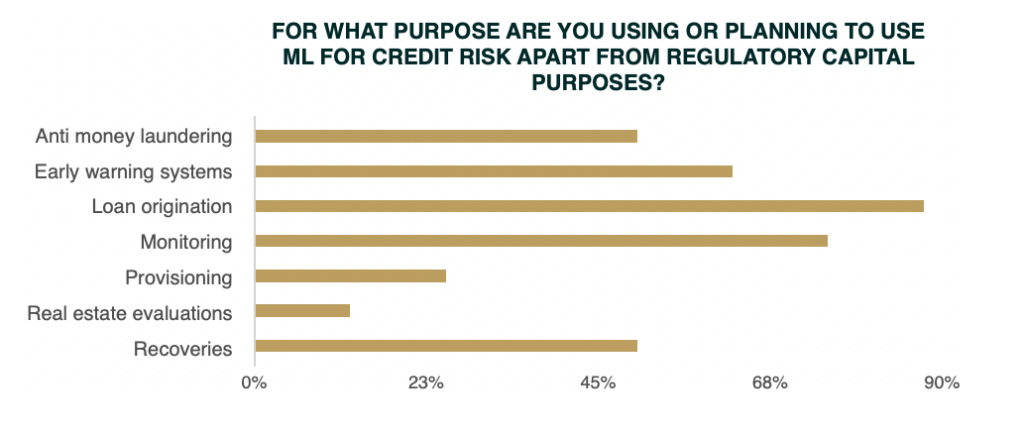
There exists a consensus among the respondents that ML is suitable for various areas within credit risk. For example, ESBG outlines that the opportunities for using ML models within the credit risk area and their advantages are endless. In particular for loan origination (admission), monitoring and early warning systems, the respondents are mutually in favor of applying ML. In general, the application of ML for these purposes is already being adopted by institutions far more than for IRB modeling.
To conclude
Banks are keen to use ML in the context of IRB modeling given the benefits achievable in both risk differentiation and risk quantification processes. The main reason for the limited use of ML in IRB modeling is the uncertainty in the supervisory process. The ball is currently in EBA’s court. The discussion paper and prospective set of principle-based recommendations to bridge the gap in institutional and regulatory expectations show EBA’s interest in making ML in IRB modeling a more common reality.
Zanders believes that institutions are best prepared for this transition by already applying ML to different fields, such as AML, application models and KYC. The EBA defines the enhancement of capacity to combat money laundering in the EU as one of its five main priorities for 2023 (EBA/REP/2022/20). This includes supporting the implementation of robust approaches to advance AML. Zanders anticipates that the technical EBA support in AML will spill over to IRB modeling in the coming three years. Zanders supports institutions in the application of ML in aforementioned fields, which will ensure that those institutions are adequately prepared to fully reap the rewards when ML in the context of IRB modeling is commonly accepted.
What can Zanders offer?
We combine deep credit risk modeling expertise with relevant experience in regulation and programming
- A Risk Advisory Team consisting of 70+ consultants with quantitative backgrounds (e.g., Econometrics and Physics)
- Strong knowledge of credit risk models
- Extensive experience with calibration and implementation of credit risk models
- We offer ready-to-use rating models, Credit Risk Academy modules and expert sessions that can be tailored to you specific needs.

Interested in ML in credit risk, Credit Risk Academy, and other regulatory capital modeling services? Please feel free to contact Jimmy Tang or Elena Paniagua-Avila.
Footnotes
1 CRR article 170(1)(f) and (3)(c), and RTS on AM of IRB articles 36(1)(a) and 37(1)(c)
2 CRR articles 170(3)(a) and (4) and 171(2) and GL on PD and LGD paragraphs 21, 25, and 121
3 RTS on AM of IRB articles 36(1)(a) and 37(1)(c)
The CGI-MP – What’s it All About and Can it Really Deliver?

Due to the changing landscape since the initial inception in 2012, the original EMIR (European Market Infrastructure Regulation) legislation has become outdated.
In this third article in the ISO 20022 series, Zanders experts Eliane Eysackers and Mark Sutton take a focused look at the Common Global Implementation Market Practice Group (CGI-MP). Explaining its role, objectives and how it has the potential to redefine what is possible in terms of taking the multi-banking cash management model to the next level. With the end-goal being a simplified, standardised, low cost, low maintenance multi-bank cash management architecture.
Who or What is the CGI-MP?
The CGI-MP was formed in October 2009, with Swift playing host for the inaugural meeting of an inclusive collaborative group of key stakeholders – banks, software vendors, corporates, national payment associations, that would redefine the competitive boundaries within the multi-banking cash management space. From these humble beginnings, the CGI-MP now has 355 members globally and has mobilized its domain expertise to create and publish implementation guidelines for the XML corporate payment message (pain.001.001.09) including an updated payment status workflow guide. The CGI-MP objective has always been crystal clear: "A corporate can use the same message structure for all their payments with all of their transaction banks reaching any payment system across the globe.”
What challenges existed with the original CGI-MP implementation guidelines?
Whilst the April 2009 ISO standards maintenance release provided the ideal opportunity to demonstrate the benefits of this initial collaboration through the inaugural implementation guidelines, the past 14 years have highlighted multiple friction points that existed around the corporate adoption of the version 3 XML payment message. So, despite the guidelines, we have witnessed significant divergence in terms of the banking communities implementation of this global financial messaging standard. The main challenges are summarized below:
- Inconsistent Payment Method Identification: Whilst the CGI-MP implementation guidelines recommended the use of standard codes, history reveals both the non-standard use of these codes and continued use of bank proprietary codes.
- Limited Adoption of Data Over-population: This was a core principle of the CGI-MP implementation guidelines which enabled the corporate community to establish a more generic core template. However, few banks actually embraced this core principle.
- Continued Focus on Unstructured Tags: Despite the guidance, the banking community has generally leveraged the unstructured tags to support local country rules like central bank reporting.
- Core References: Corporate implementations have revealed significant differences in the way the key batch and transaction references plus the payment details are supported and processed.
What is different about these new CGI-MP implementation guidelines?
The CGI-MP has taken these lessons learned from the version 3 implementations to try and remove the friction caused by the bank proprietary implementations. A core document within the implementation guidelines is Appendix B which is a supporting document that focuses on the additional specific local country rules. For example, which xml tags are used for central bank reporting in a specific country. This is important as it provides the opportunity to try and achieve a greater level of standardization around interpretation and therefore implementation of the XML payment message.
The most important difference is the ‘change of mindset’ that will be required from the banking community help deliver a win-win situation. So the CGI-MP is recommending a more prescriptive approach to the XML version 9 guidelines, which will help remove the numerous friction points that have been ‘called out’ above. Banks that follow the same ‘lift and shift’ logic to how they developed pain.001 V03, which typically followed the core logic of their own proprietary file formats will be missing a real opportunity to remove friction and accelerate implementations.
Considerations for Corporate Treasury?
The CGI-MP has now published the XML version 9 implementation guidelines, which CGI-MP member banks are now reviewing as part of their own XML version 9 service proposition. Based on the experience around the development and implementation of the original XML version 3 proposition back in 2009, banks are probably 6-9 months away from launch. However, whilst there is no requirement for the corporate community to migrate, XML version 9 presents a real possibility to:
- Remove friction between the banks.
- Simplify and standardise the XML version 3 implementation.
- Maximise the end to end benefits of structured data.
- Achieve greater bank portability.
In Summary
Considering the potential significant impact of the ‘change in mindset’ from the banking community, alignment to the CGI-MP guidelines and specifically Appendix B could become a table stake from a corporate perspective. It will be very important for the corporate community to have a very focused and structured discussion with their banking partners to help determine if the perceived benefits can materialise. And finally, as this is unproven territory, the recommendation remains on proceeding with banking partner harmonisation discussions to ensure the optimum implementation outcome.
FRTB: Profit and Loss Attribution (PLA) Analytics

Due to the changing landscape since the initial inception in 2012, the original EMIR (European Market Infrastructure Regulation) legislation has become outdated.
Under FRTB regulation, PLA requires banks to assess the similarity between Front Office (FO) and Risk P&L (HPL and RTPL) on a quarterly basis. Desks which do not pass PLA incur capital surcharges or may, in more severe cases, be required to use the more conservative FRTB standardised approach (SA).
What is the purpose of PLA?
PLA ensures that the FO and Risk P&Ls are sufficiently aligned with one another at the desk level. The FO HPL is compared with the Risk RTPL using two statistical tests. The tests measure the materiality of any simplifications in a bank’s Risk model compared with the FO systems. In order to use the Internal Models Approach (IMA), FRTB requires each trading desk to pass the PLA statistical tests. Although the implementation of PLA begins on the date that the IMA capital requirement becomes effective, banks must provide a one-year PLA test report to confirm the quality of the model.
Which statistical measures are used?
PLA is performed using the Spearman Correlation and the Kolmogorov-Smirnov (KS) test using the most recent 250 days of historical RTPL and HPL. Depending on the results, each desk is assigned a traffic light test (TLT) zone (see below), where amber desks are those which are allocated to neither red or green.

What are the consequences of failing PLA?
Capital increase: Desks in the red zone are not permitted to use the IMA and must instead use the more conservative SA, which has higher capital requirements. Amber desks can use the IMA but must pay a capital surcharge until the issues are remediated.
Difficulty with returning to IMA: Desks which are in the amber or red zone must satisfy statistical green zone requirements and 12-month backtesting requirements before they can be eligible to use the IMA again.
What are some of the key reasons for PLA failure?
Data issues: Data proxies are often used within Risk if there is a lack of data available for FO risk factors. Poor or outdated proxies can decrease the accuracy of RTPL produced by the Risk model. The source, timing and granularity also often differs between FO and Risk data.
Missing risk factors: Missing risk factors in the Risk model are a common cause of PLA failures. Inaccurate RTPL values caused by missing risk factors can cause discrepancies between FO and Risk P&Ls and lead to PLA failures.
Roadblocks to finding the sources of PLA failures
FO and Risk mapping: Many banks face difficulties due to a lack of accurate mapping between risk factors in FO and those in Risk. For example, multiple risk factors in the FO systems may map to a single risk factor in the Risk model. More simply, different naming conventions can also cause issues. The poor mapping can make it difficult to develop an efficient and rapid process to identify the sources of P&L differences.
Lack of existing processes: PLA is a new requirement which means there is a lack of existing infrastructure to identify causes of P&L failures. Although they may be monitored at the desk level, P&L differences are not commonly monitored at the risk factor level on an ongoing basis. A lack of ongoing monitoring of risk factors makes it difficult to pre-empt issues which may cause PLA failures and increase capital requirements.
Our approach: Identifying risk factors that are causing PLA failures
Zanders’ approach overcomes the above issues by producing analytics despite any underlying mapping issues between FO and Risk P&L data. Using our algorithm, risk factors are ranked depending upon how statistically likely they are to be causing differences between HPL and RTPL. Our metric, known as risk factor ‘alpha’, can be tracked on an ongoing basis, helping banks to remediate underlying issues with risk factors before potential PLA failures.

Zanders’ P&L attribution solution has been implemented at a Tier-1 bank, providing the necessary infrastructure to identify problematic risk factors and improve PLA desk statuses. The solution provided multiple benefits to increase efficiency and transparency of workstreams at the bank.
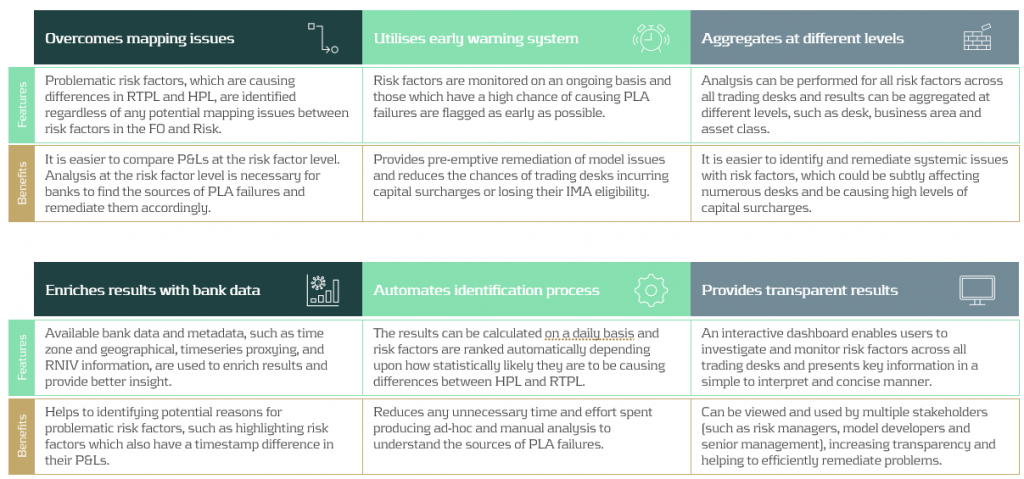
Conclusion
As it is a new regulatory requirement, passing the PLA test has been a key concern for many banks. Although the test itself is not considerably difficult to implement, identifying why a desk may be failing can be complicated. In this article, we present a PLA tool which has already been successfully implemented at one of our large clients. By helping banks to identify the underlying risk factors which are causing desks to fail, remediation becomes much more efficient. Efficient remediation of desks which are failing PLA, in turn, reduces the amount of capital charges which banks may incur.
Cryptocurrencies and Blockchain: Navigating Risk, Compliance, and Future Opportunities in Corporate Treasury

Due to the changing landscape since the initial inception in 2012, the original EMIR (European Market Infrastructure Regulation) legislation has become outdated.
As a result of the growing importance of this transformative technology and its applications, various regulatory initiatives and frameworks have emerged, such as Markets in Crypto-Assets Regulation (MiCAR), the Distributed Ledger Technology (DLT) Pilot Regime, and the Basel Committee on Banking Supervision (BCBS) crypto standard were launched, demonstrating the growing importance and adoption at both a global and national level. Given these trends, treasuries will be impacted by Blockchain one way or the other – if they aren’t already.
With the advent of cryptocurrencies and digital assets, it is important for treasurers to understand the issues at hand and have a strategy in place to deal with them. Based on our experience, typical questions that a treasurer faces are how to deal with the volatility of cryptocurrencies, how cryptocurrencies impact FX management, the accounting treatment for cryptocurrencies as well as KYC considerations. These developments are summarized in this article.
FX Risk Management and Volatility
History has shown that cryptocurrencies such as Bitcoin and Ether are highly volatile assets, which implies that the Euro value of 1 BTC can fluctuate significantly. Based on our experience, treasurers opt to sell their cryptocurrencies as quickly as possible in order to convert them into fiat currency – the currencies that they are familiar and which their cost basis is typically in. However, other solutions exist such as hedging positions via derivatives traded on regulated financial markets or conversions into so-called stablecoins1.
Accounting Treatment and Regulatory Compliance
Cryptocurrencies, including stablecoins, require careful accounting treatment and compliance with regulations. In most cases cryptocurrencies are classified as “intangible assets” under IFRS. For broker-traders they are, however, classified as inventory, depending on the circumstances. Inventory is measured at the lower of cost and net realizable value, while intangible assets are measured at cost or revaluation. Under GAAP, most cryptocurrencies are treated as indefinite-lived intangible assets and are impaired when the fair value falls below the carrying value. These impairments cannot be reversed. CBDCs, however, are not considered cryptocurrencies. Similarly, and the classification of stablecoins depends on their status as financial assets or instruments.
KYC/KYT Considerations
The adoption of cryptocurrencies and Blockchain technology introduces challenges for corporate treasurers in verifying counterparties and tracking transactions. When it comes to B2C transactions, treasurers may need to implement KYC (Know Your Customer) processes to verify the age and identity of individuals, ensuring compliance with age restrictions and preventing under-aged purchases, among other regulatory requirements. Whilst the process differs for B2B (business-to-business) transactions, the need for KYC exists nevertheless. However in the B2B space, the KYC process is less likely to be made more complex by transactions done in cryptocurrencies, since the parties involved are typically well-established companies or organizations with known identities and reputations.
Central Bank Digital Currencies
(CBDCs) are emerging as potential alternatives to privately issued stablecoins and other cryptocurrencies. Central banks, including the European Central Bank and the Peoples Banks of China, are actively exploring the development of CBDCs. These currencies, backed by central banks, introduce a new dimension to the financial landscape and will be another arrow in the quiver of end-customers – along with cash, credit and debit cards or PayPal. Corporate treasurers must prepare for the potential implications and opportunities that CBDCs may bring, such as changes in payment options, governance processes, and working capital management.
Adapting to the Future
Corporate treasurers should proactively prepare for the impact of cryptocurrencies and Blockchain technology on their business operations. This includes educating themselves on the basics of cryptocurrencies, stablecoins, and CBDCs, and investigating how these assets can be integrated into their treasury functions. Understanding the infrastructure, processes, and potential hedging strategies is crucial for treasurers to make informed decisions regarding their balance sheets. Furthermore, treasurers must evaluate the impact of new payment options on working capital and adjust their strategies accordingly.
Zanders understands the importance of keeping up with emerging technologies and trends, which is why we offer a comprehensive range of Blockchain services. Our Blockchain offering covers supporting our clients in developing their Blockchain strategy including developing proofs of concept, cryptocurrency integration into Corporate Treasury, support on vendor selection as well as regulatory advice. For decades Zanders has helped corporate treasurers navigate the choppy seas of change and disruption. We are ready to support you during this new era of disruption, so reach out to us today.
Meet the team
Zanders already has a well-positioned, diversified Blockchain team in place, consisting of Blockchain developers, Blockchain experts and business experts in their respective fields. In the following you will find a brief introduction of our lead Blockchain consultants.
ISO 20022 XML (Pain.001.001.09) – Introduction of the Structured Address

Due to the changing landscape since the initial inception in 2012, the original EMIR (European Market Infrastructure Regulation) legislation has become outdated.
However, possibly the most important point for corporates to be aware of is the planned move towards explicit use of the structured address block. In this second article in the ISO 20022 series, Zanders experts Eliane Eysackers and Mark Sutton provide some valuable insights around this industry requirement, the challenges that exists and an important update on this core topic.
What is actually happening with the address information?
One of the key drivers around the MT-MX migration are the significant benefits that can be achieved through the use of structured data. E.g., stronger compliance validation and support STP processing. The SWIFT PMPG1 (Payment Market Practice Group) had advised that a number of market infrastructures2 are planning to mandate the full structured address with the SWIFT ISO migration. The SWIFT PMPG had also planned to make the full structured address mandatory for the interbank messages – so effectively all cross-border payments. The most important point to note is that the SWIFT PMPG had also advised of the plan to reject non-compliant cross border payment messages from November 2025 in line with the end of the MT-MX migration. So, if a cross border payment did not include a full structured address, the payment instruction would be rejected.
What are the current challenges around supporting a full structured address?
Whilst the benefits of structured data are broadly recognised and accepted within the industry, a one size approach does not always work, and detailed analysis conducted by the Zanders team revealed mandating a full structured address would create significant friction and may ultimately be unworkable.

Diagram 1: Challenges around the implementation of the full structured address.
From the detailed analysis performed by the Zanders team, we have identified multiple problems that are all interconnected, and need to be addressed if the industry is to achieve its stated objective of a full structured address. These challenges are summarized below:
- Cost of change: The 2021 online TMI poll highlighted that 70% of respondents confirmed they currently merge the building name, building number, and street name in the same address line field. The key point to note is that the data is not currently separated within the ERP (Enterprise Resource Planning) system. Furthermore, 52% of these respondents highlighted a high impact to change this data, while 26% highlighted a medium impact. As part of Zanders’ continued research, we spoke to two major corporates to gain a better sense of their concerns. Both provided a high-level estimate of the development effort required for them to adapt to the new standard: ½ million euros.
- Fit for Purpose: From the ISO 20022 expert group discussions, it was recognized that the current XML Version 9 message would need a significant re-design to support the level of complexity that exists around the address structure globally.
- Vendor Support: Whilst we have not researched every ERP and TMS (Treasury Management System) system, if you compare the current structured address points including field length in the XML Version 9 message with the master data records currently available in the ERP and TMS systems, you will see gaps in terms of the fields that are supported and the actual field length. This means ERP and TMS software vendors will need to update the current address logic to fully align with the ISO standard for payments – but this software development cannot logically start until the ISO address block has been updated to avoid the need for multiple software upgrades.
- Industry Guidelines: Whilst industry level implementation guidelines are always a positive step, the current published SWIFT PMPG guidelines have primarily focused on the simpler mainstream address structures for which the current address structure is fine. By correctly including the more complex local country address options, it will quickly highlight the gaps that exist, which mean compliance by the November 2025 deadline looks unrealistic at this stage.
- Regulatory Drivers: At this stage, there is still no evidence that any of the in-country payments regulators have actually requested a full structured address. However, we have seen some countries start to request minimum address information (but not structured due to the MT file format), such as Canada and US.
- Time to Implement: We must consider the above dependencies that need to be addressed first before full compliance can logically be considered, which means a new message version would be required. Whilst industry discussions are ongoing, the next ISO maintenance release is November 2023, which will result in XML version 13 being published. If we factor in time for banks to adopt this new version (XML Version 13), time for software vendors to develop the new full structured address including field length and finally, for the corporates to then implement this latest software upgrade and test with their banking partners, the November 2025 timeline looks unrealistic at this point in time.
A very important update
Following a series of focused discussions around the potential address block changes to the XML Version 9 message, including the feedback from the GLEIF3 the ISO payment expert group questioned the need to support a significant redesign of the address block to enable the full structured address to be mandated. The Wolfsberg Group4 also raised concerns about scale of the changes required within the interbank messaging space.
Given this feedback, the SWIFT PMPG completed a survey with the corporate community in April. The survey feedback highlighted a number of the above concerns, and a change request has now been raised with the SWIFT standards working group for discussion at the end of June. The expectation is that the mandatory structured address elements will now be limited to just the Town/City, Postcode, and country, with typical address line 1 complexity continuing to be supported in the unstructured address element. This means a blended address structure will be supported.
Is Corporate Treasury Impacted by this structured address compliance requirement?
There are a number of aspects that need to be considered in answering this question. But at a high level, if you are currently maintaining your address data in a structured format within the ERP/TMS and you are currently providing the core structured address elements to your banking partners, then the impact should be low. However, Zanders recommends each corporate complete a more detailed review of the current address logic as soon as possible, given the current anticipated November 2025 compliance deadline.
In Summary
The ISO 20022 XML financial messages offer significant benefits to the corporate treasury community in terms more structured and richer data combined with a more globally standardised design. The timing is now right to commence the initial analysis so a more informed decision can be made around the key questions.
Notes:
- The PMPG (payment market practice group) is a SWIFT advisory group that reports into the Banking Services Committee (BSC) for all topics related to SWIFT.
- A Market Infrastructure is a system that provides services to the financial industry for trading, clearing and settlement, matching of financial transactions, and depository functions. For example, in-country real-time gross settlement (RTGS) operators (FED, ECB, BoE).
- Global Legal Entity Identifier Foundation (Established by the Financial Stability Board in June 2014, the GLEIF is tasked to support the implementation and use of the Legal Entity Identifier (LEI).
- https://www.wolfsberg-principles.com/sites/default/files/wb/pdfs/wolfsberg-standards/1.%20Wolfsberg-Payment-Transparency-Standards-October-2017.pdf




